5
Features & Characteristics of Prams and Strollers
Basic Features of Prams and Strollers
Features of Prams and Strollers are based on safety, comfort, convenience and
practicability of them.
You will find that convenience and practicability are categories that are parent-specific
(ease of folding, maneuverability, etc.), whereas safety and comfort are oriented more
towards the child (braking system, padding, etc.).

If more than one person is going to push your child’s stroller then height of each person is obviously going to be different from the other. Then the height adjustable handle stroller could be ergonomically practical for you. The handle should be waist-high or slightly below. A single bar-handle is easy to maneuver with one hand, leaving your other hand free. A soft rubber/foam grip is comfortable, absorbs the sweat from your palms and helps you get a firm grip.
Some strollers have brakes you can engage while on the move or at a standstill. Just be careful not to stub your toes while walking. Some strollers feature an optional speed control, which can be helpful in ensuring that the safety of your little one lies in the hands of the person pushing the carriage.
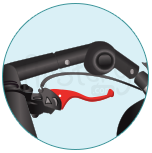
Hand brakes are convenient where pressing the brake lever by foot is not possible. Most of the Jogging strollers come with hand brake.
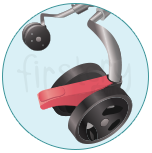
Foot-action brakes make a convenient option for when you’ve got your hands full.
Front wheel brakes make sure stability by controlling roll over.
Back wheel brakes are very common, are very easy to exercise quick control.
All wheel brakes gives supreme control.
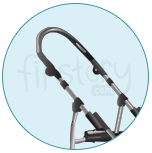
Frame should be light and manageable for you to handle, yet sturdy enough to provide ample protection to your child. There are plenty of light-weight yet sturdy-framed carriers available in the market to handle the combined weight of baby, and the contents of the storage basket.
Minimum width of 20mm. It must either be directly secured to the frame, or to the back, which in turn is secured to the frame.
Minimum width of 20mm. It must either be directly secured to the frame, or to the seat, which in turn is secured to the frame.
Minimum width of 20mm. It must be attached to the front of the waist strap and must be not more than 200 mm away from the back rest.
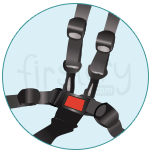
It has 5 safety straps that are 2 chest straps, 2 waist straps and 1 crotch strap available to secure your baby. A 5-point harness is considered as the safest, for smaller babies.
It has 3 safety straps that are either 2 chest straps or 2 waist straps and 1 crotch strap available to secure your baby. A 3-point harness is considered as the safest for independent sitters and toddlers.
It has 2 safety straps at waist that are available to secure your baby. A 2-point harness is considered as the safest for toddlers and older children.
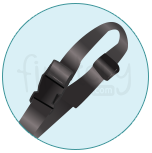
A tether strap works the same way as tethering your dog - it keeps the stroller bound to you at all times, whether or not parking brakes are applied. This acts as an extra but necessary precaution while your stroller is stationary, and will be very useful in case the brakes give away or the stroller slips away. The strap should be designed such that it is neither too long to become a potential strangulation hazard, or too short to be inconvenient.
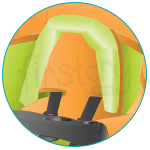
Strollers tend to have less cushioning as compared to prams. Some models have ergosoft cushioning with a fabric that can breathe, making them more comfortable for your baby. You may also notice a few strollers with padded shoulder straps, for added comfort.
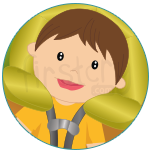
A head barrier is necessary to ensure that the child’s head does not loll over and get entrapped between the frames. This is especially useful while placing small babies, who are not independent sitters yet, in strollers that have a reclining position of an angle greater than 150°. This also applies to strollers that have multiple recline positions or twin seating.
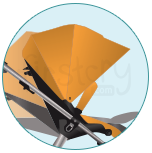
Any Pram or Stroller that bends beyond 150° should be good from newborn (their necks aren’t yet strong enough to sit upright) to toddler phase (because they get sleepy). Recline options include a lever, buttons, and a strap or drawstring or a back bar- some smoother than others. The best ones can be operated with one hand and are easy to use, even with a child in the seat.
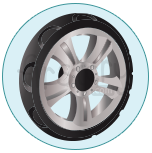
Larger wheels provide more stability, but can be a nuisance when it comes to storage space.
When it comes to giving your baby the best quality ride, ditch the plastic tires and opt for the following types of tires -
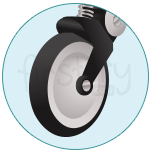
Air-filled tires are the most comfortable of all, but they can get punctured. They need time to time maintenance.
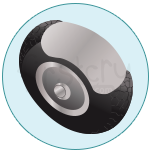
They ensure fewer jerks and shocks, especially for younger babies. They cannot get punctured.
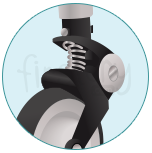
If you plan on taking your baby out for walks, you’ll have to watch out for bumps (especially if it’s a newborn). Look for large wheels and a good suspension, so the baby doesn’t get rocked a lot.
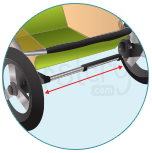
A wider base makes for a sturdier, hardier stroller; the seating is far more comfortable too. A longer wheelbase would add to stability, but decrease the turning radius, making it hard to turn in tight spaces. And of course, every inch you add will reduce that much of boot space.
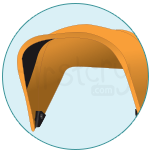
Most Prams and Strollers come with adjustable shades or canopies to protect your baby from the sun, but there are other interesting accessories you can pick up, like a rain cover or a UV-protective sun shade, to protect your baby during outdoor trips. Some canopies come with a peek-a-boo window, so you can keep an eye on your baby while on the go. You’ll be especially thankful for a detachable one, when it needs cleaning.
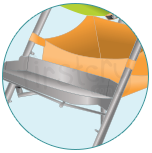
This is a feature that you won’t need until your baby grows a little older. A footrest adds to the length of the seat and provides calf support for your toddler. Most footrests are adjustable, with anywhere between 2 and 6 positions, and can be adjusted at the press of a button, release of a lever or can simply be pulled into position.
Most Prams and Strollers come with an attachable mosquito net to protect your baby from mosquito bites and that of other insects.
If you are looking for a Pram or Stroller that is easier to fold and handle, there are options that provide simple folding mechanisms. Check the folded dimensions of your carriage against the boot space in your vehicle (most strollers are between 95cm and 115cm long when folded).
A quick one-hand motion could mean that you can stow the carriage into the boot of your car while balancing your baby on your hip. It’s easier to store a carriage that stands independently upright (or locks easily) when folded than one that doesn’t.
Some lightweight strollers can be folded like an umbrella, so they are also called umbrella strollers.
Some strollers are made in such a way that they become very compact when folded and are easy to carry as well as store.
To organize bottles, keys, teething rings, and other accessories for parents. Child trays give babies a place to eat, while on the go.
To keep your baby entertained.
In most modern Prams and Strollers, the direction of the seat can be reversed. Prams are typically rear-facing, while stroller frames are compatible with rear-facing bassinets or car seats for newborns.
Strollers come with reversible handles that can be positioned to make your child face you on the rear, or forward, according to the child’s age and mood.
Many Prams and Strollers come with storage baskets. These baskets, of variable sizes, are situated under the seat, and when loaded, help increase your carriage’s center of gravity, thereby giving it additional stability. Some strollers provide a rear pocket to store quick essentials, like your purse or mobile phones, so you don’t have to bend to reach your phone or purse, every time you want to use it.
Swivel wheels make a stroller easy to maneuver, while fixed wheels make handling easier over rough surfaces. A stroller that has swiveled wheels should be locked, for extra stability. Some jogging strollers come with swiveling front wheels too, and they are more suitable for a combination of walking and jogging.

Height Adjustable Handle
If more than one person is going to push your child’s stroller then height of each person is obviously going to be different from the other. Then the height adjustable handle stroller could be ergonomically practical for you. The handle should be waist-high or slightly below. A single bar-handle is easy to maneuver with one hand, leaving your other hand free. A soft rubber/foam grip is comfortable, absorbs the sweat from your palms and helps you get a firm grip.
Brake Mechanism
Some strollers have brakes you can engage while on the move or at a standstill. Just be careful not to stub your toes while walking. Some strollers feature an optional speed control, which can be helpful in ensuring that the safety of your little one lies in the hands of the person pushing the carriage.

Hand Brake
Hand brakes are convenient where pressing the brake lever by foot is not possible. Most of the Jogging strollers come with hand brake.

Foot Brake
Foot-action brakes make a convenient option for when you’ve got your hands full.
Front Wheel Brakes
Front wheel brakes make sure stability by controlling roll over.
Back Wheel Brakes
Back wheel brakes are very common, are very easy to exercise quick control.
All Wheel Brakes
All wheel brakes gives supreme control.

Frame
Frame should be light and manageable for you to handle, yet sturdy enough to provide ample protection to your child. There are plenty of light-weight yet sturdy-framed carriers available in the market to handle the combined weight of baby, and the contents of the storage basket.
Type of Straps
Chest Straps
Minimum width of 20mm. It must either be directly secured to the frame, or to the back, which in turn is secured to the frame.
Waist Straps
Minimum width of 20mm. It must either be directly secured to the frame, or to the seat, which in turn is secured to the frame.
Crotch Straps
Minimum width of 20mm. It must be attached to the front of the waist strap and must be not more than 200 mm away from the back rest.
Types of Harnesses

5-Point Harness
It has 5 safety straps that are 2 chest straps, 2 waist straps and 1 crotch strap available to secure your baby. A 5-point harness is considered as the safest, for smaller babies.
3-Point Harness
It has 3 safety straps that are either 2 chest straps or 2 waist straps and 1 crotch strap available to secure your baby. A 3-point harness is considered as the safest for independent sitters and toddlers.
2-Point Harness
It has 2 safety straps at waist that are available to secure your baby. A 2-point harness is considered as the safest for toddlers and older children.

Tether Strap
A tether strap works the same way as tethering your dog - it keeps the stroller bound to you at all times, whether or not parking brakes are applied. This acts as an extra but necessary precaution while your stroller is stationary, and will be very useful in case the brakes give away or the stroller slips away. The strap should be designed such that it is neither too long to become a potential strangulation hazard, or too short to be inconvenient.

Padding
Strollers tend to have less cushioning as compared to prams. Some models have ergosoft cushioning with a fabric that can breathe, making them more comfortable for your baby. You may also notice a few strollers with padded shoulder straps, for added comfort.

Head Barrier
A head barrier is necessary to ensure that the child’s head does not loll over and get entrapped between the frames. This is especially useful while placing small babies, who are not independent sitters yet, in strollers that have a reclining position of an angle greater than 150°. This also applies to strollers that have multiple recline positions or twin seating.

Reclining Seat
Any Pram or Stroller that bends beyond 150° should be good from newborn (their necks aren’t yet strong enough to sit upright) to toddler phase (because they get sleepy). Recline options include a lever, buttons, and a strap or drawstring or a back bar- some smoother than others. The best ones can be operated with one hand and are easy to use, even with a child in the seat.

Large Wheels
Larger wheels provide more stability, but can be a nuisance when it comes to storage space.
Tires
When it comes to giving your baby the best quality ride, ditch the plastic tires and opt for the following types of tires -

Air-Filled Tires
Air-filled tires are the most comfortable of all, but they can get punctured. They need time to time maintenance.

Foam-Filled Tires
They ensure fewer jerks and shocks, especially for younger babies. They cannot get punctured.

Suspension
If you plan on taking your baby out for walks, you’ll have to watch out for bumps (especially if it’s a newborn). Look for large wheels and a good suspension, so the baby doesn’t get rocked a lot.

Wide Wheel Base
A wider base makes for a sturdier, hardier stroller; the seating is far more comfortable too. A longer wheelbase would add to stability, but decrease the turning radius, making it hard to turn in tight spaces. And of course, every inch you add will reduce that much of boot space.

Protective Shade / Canopy
Most Prams and Strollers come with adjustable shades or canopies to protect your baby from the sun, but there are other interesting accessories you can pick up, like a rain cover or a UV-protective sun shade, to protect your baby during outdoor trips. Some canopies come with a peek-a-boo window, so you can keep an eye on your baby while on the go. You’ll be especially thankful for a detachable one, when it needs cleaning.

Footrest
This is a feature that you won’t need until your baby grows a little older. A footrest adds to the length of the seat and provides calf support for your toddler. Most footrests are adjustable, with anywhere between 2 and 6 positions, and can be adjusted at the press of a button, release of a lever or can simply be pulled into position.
Mosquito Net
Most Prams and Strollers come with an attachable mosquito net to protect your baby from mosquito bites and that of other insects.
Folding Mechanism
If you are looking for a Pram or Stroller that is easier to fold and handle, there are options that provide simple folding mechanisms. Check the folded dimensions of your carriage against the boot space in your vehicle (most strollers are between 95cm and 115cm long when folded).
One-Hand Fold
A quick one-hand motion could mean that you can stow the carriage into the boot of your car while balancing your baby on your hip. It’s easier to store a carriage that stands independently upright (or locks easily) when folded than one that doesn’t.
Umbrella Fold
Some lightweight strollers can be folded like an umbrella, so they are also called umbrella strollers.
Compact Fold
Some strollers are made in such a way that they become very compact when folded and are easy to carry as well as store.
Parent Tray and Child Tray
To organize bottles, keys, teething rings, and other accessories for parents. Child trays give babies a place to eat, while on the go.
Toy Attachments
To keep your baby entertained.
Reversible Seat
In most modern Prams and Strollers, the direction of the seat can be reversed. Prams are typically rear-facing, while stroller frames are compatible with rear-facing bassinets or car seats for newborns.
Reversible Handle
Strollers come with reversible handles that can be positioned to make your child face you on the rear, or forward, according to the child’s age and mood.
Storage Basket
Many Prams and Strollers come with storage baskets. These baskets, of variable sizes, are situated under the seat, and when loaded, help increase your carriage’s center of gravity, thereby giving it additional stability. Some strollers provide a rear pocket to store quick essentials, like your purse or mobile phones, so you don’t have to bend to reach your phone or purse, every time you want to use it.
Swivel Wheels
Swivel wheels make a stroller easy to maneuver, while fixed wheels make handling easier over rough surfaces. A stroller that has swiveled wheels should be locked, for extra stability. Some jogging strollers come with swiveling front wheels too, and they are more suitable for a combination of walking and jogging.
Important Characteristics of Prams & Strollers
Whether you are buying a pram or a stroller, or any of the different hybrids in between,
there are some characteristics you need to look for in the carriage to ensure your
convenience and your child’s safety. The most important things to look out for are -
Some strollers tend to be lighter and less sturdy than others. You will find that umbrella strollers, jogging strollers and stroller frames weigh much less than prams, travel systems or standard strollers. Also, double or triple strollers are inherently bulky and occupy a lot of space, owing to their dimensions. The lack of stability in light-weight strollers makes them unsuitable for newborns, whose delicate necks need the steadiness of a sturdy carriage. Strollers are more suitable for toddlers and older kids.
Larger wheels, better suspension and more comfortable seating make a ride smooth. These are best for a newborn because newborns are delicate. Strollers for toddlers and older kids have comparatively smaller wheels.
While strollers with narrower width and smaller wheels are lighter and easier to manage in crowded spaces, prams and strollers that are more sturdy tend to have larger and better swivel/locking wheels, making them easier to maneuver and more convenient over longer distances.
More flexibility means more comfort. Babies need not wake up when being moved from car to home or the other way around, because the stroller itself acts as a baby carrier or a bassinette. While there may be key differences between types of strollers and prams, there are plenty of hybrids with cross-features. There are strollers with reclining seats and reversible handles, and prams with larger wheels and comfortable suspensions.
Weight
Some strollers tend to be lighter and less sturdy than others. You will find that umbrella strollers, jogging strollers and stroller frames weigh much less than prams, travel systems or standard strollers. Also, double or triple strollers are inherently bulky and occupy a lot of space, owing to their dimensions. The lack of stability in light-weight strollers makes them unsuitable for newborns, whose delicate necks need the steadiness of a sturdy carriage. Strollers are more suitable for toddlers and older kids.
Quality of Ride
Larger wheels, better suspension and more comfortable seating make a ride smooth. These are best for a newborn because newborns are delicate. Strollers for toddlers and older kids have comparatively smaller wheels.
Maneuverability
While strollers with narrower width and smaller wheels are lighter and easier to manage in crowded spaces, prams and strollers that are more sturdy tend to have larger and better swivel/locking wheels, making them easier to maneuver and more convenient over longer distances.
Flexibility
More flexibility means more comfort. Babies need not wake up when being moved from car to home or the other way around, because the stroller itself acts as a baby carrier or a bassinette. While there may be key differences between types of strollers and prams, there are plenty of hybrids with cross-features. There are strollers with reclining seats and reversible handles, and prams with larger wheels and comfortable suspensions.
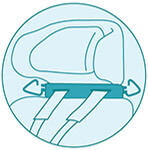
Latch Adjuster
This will help kids learn spellings in a fun way. One crib is that the alphabets do not really fit in well with the board. Only the correct spelling is supposed to fit the board exactly but its not so. This will help kids learn spellings in a fun way. One crib is that the alphabets do not really
This will help kids learn spellings in a fun way. One crib is that the alphabets do not really fit in well with the board. Only the correct spelling is supposed to fit the board exactly but its not so. This will help kids learn spellings in a fun way. One crib is that the alphabets do not really
